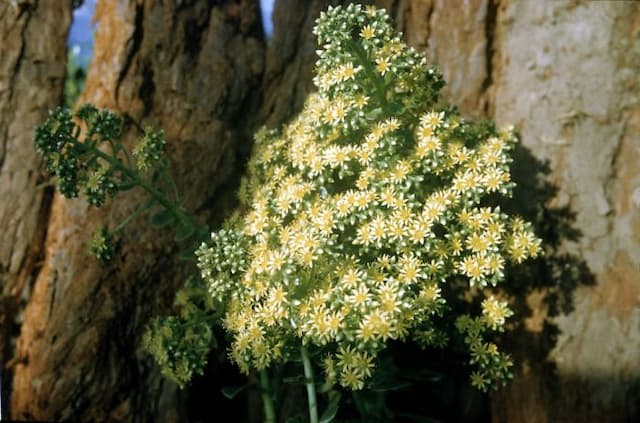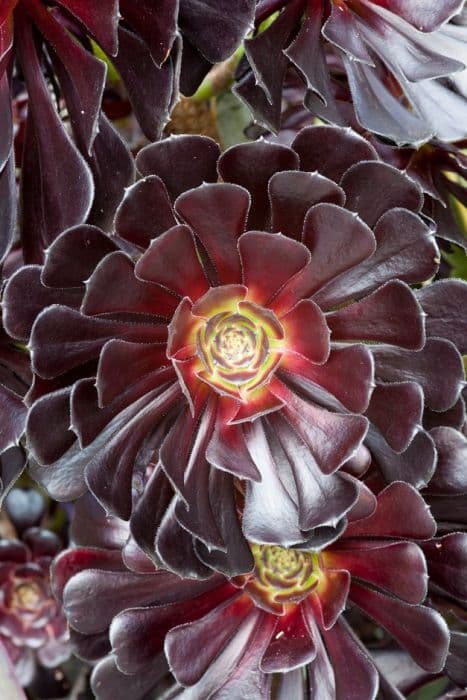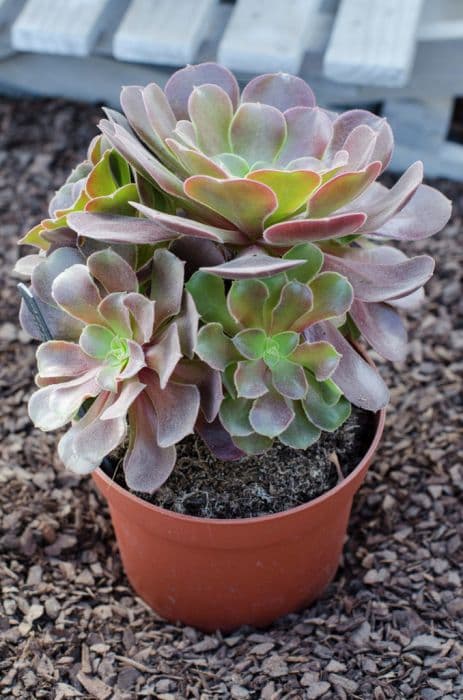Tree Houseleek Aeonium 'Du Rozzen'

ABOUT
The Aeonium 'Du Rozzen', often known simply as Aeonium, is a striking succulent that boasts a rosette-forming growth habit. This plant is characterized by fleshy, spoon-shaped leaves that are rich in color, typically displaying a blend of green, burgundy, and sometimes yellow hues. The leaves are glossy and can appear almost metallic or iridescent under certain lighting conditions. The rosettes of the Aeonium 'Du Rozzen' are neatly arranged, with each leaf overlapping the next in a compact spiral pattern that emanates from the center of the rosette. Over time, the Aeonium 'Du Rozzen' may produce offsets or clusters of rosettes, giving it a full and lush appearance. The plant's overall form is quite sculptural and can add a dramatic touch to succulent arrangements or rock gardens. It's also worth noting that, like other Aeonium species, 'Du Rozzen' can bear small, star-shaped flowers that grow in clusters on a stem protruding from the central rosette, although the plant is primarily grown for its attractive foliage rather than its blooms.
About this plant
 Names
NamesSynonyms
Tree Houseleek, Irish Rose, Aeonium 'Du Rozzen'.
Common names
Aeonium 'Du Rozzen'.
 Toxicity
ToxicityTo humans
Aeoniums, including Aeonium 'Du Rozzen', are generally considered non-toxic to humans. However, it is always good practice to avoid ingesting plants that are not intended for consumption, as individual reactions can vary. If large amounts of the plant are accidentally ingested, there might be a risk of mild gastrointestinal upset, such as nausea or diarrhea.
To pets
Aeoniums, including Aeonium 'Du Rozzen', are not known to be toxic to cats, dogs, or other pets. While they are generally safe, it's still a good practice to prevent pets from chewing on plants. Some animals might have a sensitive stomach and could experience mild vomiting or diarrhea if they consume parts of this succulent.
 Characteristics
CharacteristicsLife cycle
Perennials
Foliage type
Evergreen
Color of leaves
Mixed
Height
2 feet (60 cm)
Spread
2 feet (60 cm)
Plant type
Succulent
Hardiness zones
9
Native area
Canary Islands
Benefits
 General Benefits
General Benefits- Ornamental Appeal: Aeonium 'Du Rozzen' adds aesthetic value to gardens and homes with its rosette-shaped leaves and deep coloration.
- Drought Tolerance: Being a succulent, it can survive with minimal water, making it ideal for xeriscaping and low-maintenance gardens.
- Easy Propagation: Aeoniums can be easily propagated from cuttings, allowing gardeners to expand their collection or share with others.
- Container Gardening: Its compact size makes it suitable for growing in pots, ideal for balconies, patios, or indoors.
- Seasonal Interest: This plant can change hues depending on the season or sun exposure, with colors intensifying in cooler temperatures or with more sunlight.
 Medical Properties
Medical PropertiesThis plant is not used for medical purposes.
 Air-purifying Qualities
Air-purifying QualitiesThis plant is not specifically known for air purifying qualities.
 Other Uses
Other Uses- Aeonium 'Du Rozzen', commonly known as Tree Houseleek, can be used in creating living sculptures by planting them in a variety of shapes and structures due to their sculptural rosettes.
- The rosettes of the Tree Houseleek make visually striking natural jewelry, such as brooches or hair accessories, when attached properly to bases.
- The contrasting colors and patterns of the Tree Houseleek's leaves can be used in artistic photography, serving as an organic and intriguing subject matter.
- Tree Houseleek can be employed in educational environments, such as schools or botanical gardens, to teach about succulent care and propagation.
- The plant's ability to withstand drought and intense sunlight makes it ideal for use in green roofs or living walls, providing insulation and aesthetic appeal.
- Tree Houseleek can be used as a natural mulch in gardens, as their thick leaves can retain moisture in the soil when fallen.
- Due to their unique rosettes, Tree Houseleeks can be utilized in fantasy-themed gardens or landscapes, contributing to a whimsical environment.
- In floral arrangements, the cut rosettes of Tree Houseleek can offer an exotic and durable alternative to traditional flowers.
- For culinary presentation, the rosettes can serve as an intriguing and edible garnish on food platters, as long as no pesticides have been used.
Interesting Facts
 Feng Shui
Feng ShuiThe Tree Houseleek is not used in Feng Shui practice.
 Zodiac Sign Compitability
Zodiac Sign CompitabilityThe Tree Houseleek is not used in astrology practice.
 Plant Symbolism
Plant Symbolism- Resilience: Aeoniums are known for their ability to survive in tough conditions. The Aeonium 'Du Rozzen', like other Aeoniums, symbolizes strength and the capacity to endure challenging environments. This is due to their succulent nature, which allows them to retain water and adapt to dry, arid climates.
- Timelessness: The Aeonium 'Du Rozzen' has a rosette pattern that is often associated with the geometric perfection of nature and can be seen as a symbol of eternity and timeless beauty.
- Variety and Uniqueness: With its deep red to purple leaves, Aeonium 'Du Rozzen' represents diversity and the uniqueness of individuals, as each plant can have slight variations in color and form, celebrating the beauty of diversity.
- Prosperity and Wealth: In some cultures, succulents like Aeonium 'Du Rozzen' can signify wealth and prosperity, possibly due to their lush, full-bodied appearance and the association of green with growth and financial success.
 Water
WaterThe Aeonium 'Du Rozzen', commonly known as Tree Houseleek, should be watered thoroughly but infrequently, allowing the soil to dry out completely before the next watering. This drought-tolerant plant prefers less water than more humid-loving plants, typically needing water once every two weeks during the active growing season. In the winter, when the plant is dormant, reduce watering to once a month or less, depending on the humidity of your environment. When you do water, apply enough to soak the soil evenly, which might be around 8 to 16 ounces, depending on pot size. Be wary of overwatering as this can lead to root rot, a common issue with succulents.
 Light
LightThe Tree Houseleek thrives best in a spot that receives plenty of bright, indirect sunlight. It can tolerate some direct sun, but in very hot climates, it's beneficial to provide afternoon shade to prevent sunburn. Ideally, place your Tree Houseleek in a location where it receives at least six hours of sunlight daily, such as a south or west-facing window for those living in the Northern Hemisphere.
 Temperature
TemperatureFor the Tree Houseleek, an ideal temperature range lies between 65°F and 75°F. It can tolerate temperatures as low as 40°F and as high as 90°F, but prolonged exposure to extremes can be detrimental. Avoid placing the plant near drafty windows or vents where it could experience sudden temperature fluctuations.
 Pruning
PruningPruning the Tree Houseleek is generally done to remove any dead or damaged leaves and to maintain its shape. It is best to prune in the springtime, just before the growing season begins. Occasional pruning also encourages fresh growth and can be done every few years as needed. Use sharp, clean shears to make precise cuts and reduce the risk of infection.
 Cleaning
CleaningAs needed
 Soil
SoilAeonium 'Du Rozzen,' commonly known as Tree Houseleek, requires well-draining soil with a pH of around 6.0 to 7.5. A mixture of one part perlite, one part coarse sand, and two parts potting soil creates an ideal mix. This blend ensures adequate drainage to prevent root rot, which is crucial for the health of the succulent.
 Repotting
RepottingTree Houseleeks, like Aeonium 'Du Rozzen,' should be repotted approximately every two to three years. Repotting should be done during the growing season, typically spring or early summer, to allow the plant to acclimate and establish its root system in the fresh soil.
 Humidity & Misting
Humidity & MistingTree Houseleeks, such as Aeonium 'Du Rozzen,' prefer dry to moderate humidity conditions. They thrive in humidity levels typical of indoor environments, around 40% to 50%. These plants are adaptable to less humid conditions and require no extra atmospheric moisture than what's generally found in a household.
 Suitable locations
Suitable locationsIndoor
Place in bright indirect light and ensure good air flow.
Outdoor
Grow in partial sun, sheltered from harsh afternoon rays.
Hardiness zone
9-11 USDA
 Life cycle
Life cycleAeonium 'Du Rozzen', commonly known as tree houseleek, starts its life as a seed, often sprouting within a soil mixture that's well-draining and sandy. As a juvenile, it develops a small rosette of succulent leaves and begins to establish a shallow root system. As it matures, the rosette expands, and the plant forms a woody stem that may branch, creating multiple rosettes and reaching its full size which can be several feet high. During its reproductive stage, usually in the spring or early summer, it produces pyramidal inflorescences with numerous small, star-shaped flowers. After flowering, which is often triggered by stress or a seasonal stimulus, the main rosette that has bloomed typically dies, but the plant continues to live on through offsets or pups that grow from the base or branches. The life span of an Aeonium 'Du Rozzen' can vary, but with proper care, it can live for several years, going through multiple cycles of growth and reproduction.
 Propogation
PropogationPropogation time
Spring to Summer
Aeonium 'Du Rozzen', also known as Aeonium 'Zwartkop', is a popular succulent plant that can be propagated mainly through cuttings. The optimal time for propagation is during its active growth phase, which is typically in the spring or early summer. To propagate by cuttings, a healthy leaf or stem is selected and cleanly snipped off using a sharp, sterilized knife or scissors. The cut end of the leaf or stem should be allowed to callous over for a few days before it is placed in soil. A well-draining cactus or succulent mix is the ideal medium for rooting. The cutting should be placed just on top of the soil, ensuring that the calloused end is in contact with the soil. The soil should be kept slightly moist but not wet, and the cutting should be placed in a warm spot with indirect light until roots have developed, which usually takes a few weeks. After the cutting has rooted and shows signs of growth, it can be cared for like a mature plant.









